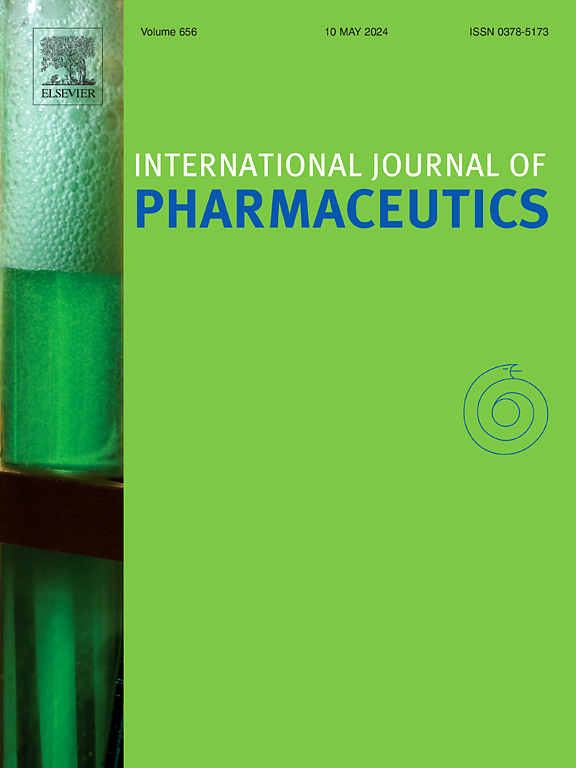3D打印部分涂覆的漂浮系统,用于控制药物释放到胃中
IF 5.3
2区 医学
Q1 PHARMACOLOGY & PHARMACY
引用次数: 0
摘要
这项工作的重点是开发一种能够漂浮在胃液中的潴留给药系统(DDS),确保药物在预定时间内长时间释放,然后安全地从胃中排出。为此,设计步骤发挥了关键作用。因此,我们设计了一种由聚乙烯醇基基质组成的锥形装置,基质的部分表面涂有一层不溶性的热塑性弹性体。这样,作为模型药物的别嘌醇(ALP)只能从未涂覆的表面释放,而亲水性可溶胀/可渗透基质的特殊几何形状旨在通过扩大释放区域来平衡扩散路径随时间的增加。此外,涂层上还有气囊,其大小可以补偿 DDS 浸入胃液后的重量力,从而确保其具有持久的浮力。当基质完全耗尽时,这些气囊会缓和胃液的进入,从而有利于 DDS 从幽门下沉和移除。考虑到最终漂浮装置的多层几何形状,包括难以制造的细节(如无涂层表面、空隙),熔融沉积建模 3D 打印技术因其在制造复杂形状方面的有效性而被确定为首选技术。对制造内基质和外涂层的各种配方进行了测试,评估了它们的热机械性能、可印刷性和释放行为。胃保留系统表现出了较长的浮力(12 小时)和广泛的 ALP 释放性能组合(释放速度和持续时间各不相同),使其成为在上消化道进行个性化给药的理想平台。本文章由计算机程序翻译,如有差异,请以英文原文为准。

3D printing of partially-coated floating systems for controlled release of drugs into the stomach
This work focused on the development of a retentive drug delivery system (DDS) able to float in the gastric fluids and to ensure prolonged release of drugs over a pre-defined period of time, being then safely emptied from the stomach. To this end, the design step played a pivotal role. The device was thus devised to be composed of a polyvinyl alcohol-based matrix with a tapered geometry, which was partially coated with an insoluble layer of thermoplastic elastomer. This way, release of allopurinol (ALP), used as model drug, could occur only from the uncoated surfaces, while the peculiar geometry of the hydrophilic swellable/erodible matrix was intended to balance the increase in the diffusional path over time with a wider release area. In addition, the coating featured air pockets, whose volume was sized to compensate for the weight force of the DDS once immersed in gastric fluids, thus ensuring its long-lasting buoyancy. By easing the entrance of gastric fluids when the matrix is completely exhausted, such air pockets would also favor sinking and removal of the DDS from the pylorus. Given the multi-layered geometry of the final floating device, including hard-to-fabricate details (e.g. uncoated surfaces, voids), fused deposition modeling 3D printing was identified as the technique of choice for its effectiveness in manufacturing complex shapes. Various formulations were tested for fabricating both the inner matrix and the outer coating, assessing their thermo-mechanical properties, printability and release behavior. The gastro-retentive system demonstrated prolonged buoyancy (> 12 h) and a wide portfolio of ALP release performances, differing in rate and duration, which would make it a promising platform for personalized delivery of drugs in the upper gastrointestinal tract.
求助全文
通过发布文献求助,成功后即可免费获取论文全文。
去求助
来源期刊
CiteScore
10.70
自引率
8.60%
发文量
951
审稿时长
72 days
期刊介绍:
The International Journal of Pharmaceutics is the third most cited journal in the "Pharmacy & Pharmacology" category out of 366 journals, being the true home for pharmaceutical scientists concerned with the physical, chemical and biological properties of devices and delivery systems for drugs, vaccines and biologicals, including their design, manufacture and evaluation. This includes evaluation of the properties of drugs, excipients such as surfactants and polymers and novel materials. The journal has special sections on pharmaceutical nanotechnology and personalized medicines, and publishes research papers, reviews, commentaries and letters to the editor as well as special issues.

 求助内容:
求助内容: 应助结果提醒方式:
应助结果提醒方式:


